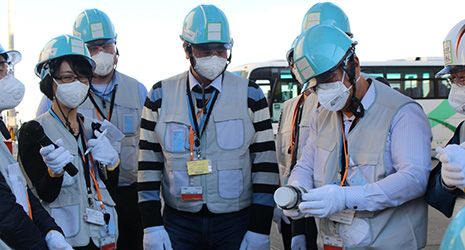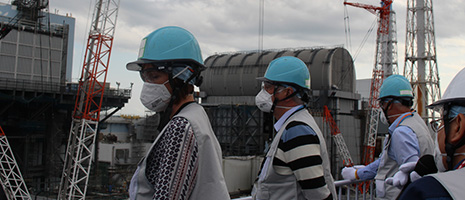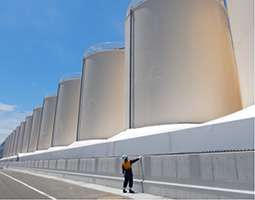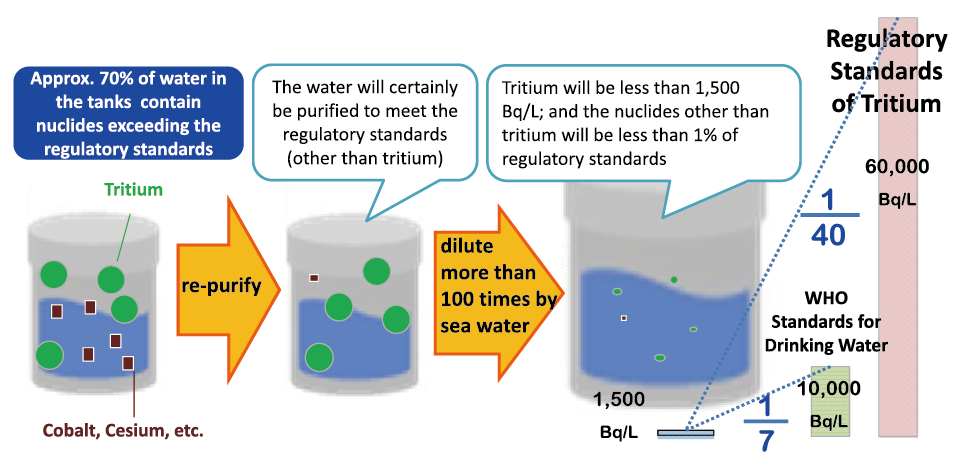INDEX
- English
- 日本語

IAEA officials and experts looking at a bottle containing a sample of ALPS treated water at the Fukushima Daiichi Nuclear Power Station in November 2021 - English
- 日本語

IAEA officials and experts inspecting the Fukushima Daiichi Nuclear Power Station in November 2021

Storage tanks for ALPS treated water
December 2021
Decommissioning of Fukushima Daiichi Nuclear Power Station and ALPS Treated Water

In April 2021, the government of Japan decided on a policy to discharge ALPS (Advanced Liquid Processing System) treated water stored at the site of the Tokyo Electric Power Company Holdings (TEPCO) Fukushima Daiichi Nuclear Power Station (hereinafter “Fukushima Daiichi NPS”) into the sea, in order to safely and steadily proceed with the decommissioning of the Fukushima Daiichi NPS for the reconstruction of Fukushima. Preparations are now under way to implement this policy in cooperation with the international community while ensuring the safety of the operation.

The Great East Japan Earthquake that occurred on March 11, 2011 caused the Fukushima Daiichi NPS to lose all power, which led to the loss of the stable cooling function of the reactors. This resulted in damage to the reactor cores from the high-temperature fuel, and the release of radioactive materials into the atmosphere. However, the cooling of the reactors and other measures taken immediately following the accident achieved a “cold shutdown” in December 2011, since which time the release of radioactive materials has been kept to a very low level.
Immediately following the accident, an evacuation order was issued to approximately 81,000 residents in twelve municipalities in the vicinity of the Fukushima Daiichi NPS. However, as a result of the removal of radioactive materials and restoration work on infrastructure, the evacuation order has been lifted in all areas in six municipalities and in most areas in the remaining six municipalities as of December 2021, reducing the number of people still subject to the evacuation order to 22,000.
Moreover, while the accident led to the imposition of import restrictions on food products from Japan by fifty-five countries and regions, that number has been decreasing year by year, with 2021 seeing the lifting of restrictions by Israel, Singapore and the United States. Of the fourteen countries and regions that continue to impose import restrictions, nine allow the import of food products accompanied by a test certificate.

Discharge of ALPS treated water
The reactor buildings of Unit 1, Unit 2, and Unit 3 of the Fukushima Daiichi NPS still contain “fuel debris,” which is melted fuel mixed with structural materials that has solidified. These buildings are continuously cooled with water to maintain a cool temperature, and the water used for cooling is contaminated by radioactive materials. In order to reduce the risk of radiation from the contaminated water, the Fukushima Daiichi NPS is using a purification system called ALPS (Advanced Liquid Processing System) to remove radioactive materials.
One of the major challenges for the decommissioning of the Fukushima Daiichi NPS has been this method for handling the ALPS treated water (hereinafter “treated water”). Although most of the radioactive materials have been removed by the purification process, concerns have been expressed about the social impact that may arise from the discharge such as adverse impacts on reputation.
A particular point of contention has been tritium, which cannot be removed by the purification process. Tritium is a relative of hydrogen and exists in drinking water, food and the human body. Tritium produced in nuclear power stations and reprocessing facilities has been discharged from many nuclear facilities around the world into the oceans, rivers and the atmosphere in compliance with national and local laws and regulations. No effects ascribed to tritium have been found in the vicinity of those facilities.
The tanks used to store the treated water take up a great deal of space, making it difficult to secure the site to allow the decommissioning of the Fukushima Daiichi NPS. For this reason, in April 2021 the government of Japan decided on a policy to discharge the treated water into the sea following a preparation period of around two years. In order to maintain strict compliance with laws and regulations related to safety and to minimize adverse impacts on reputation to the maximum extent possible, the policy states that treated water should be diluted more than 100 times using seawater in order to reduce the concentration of tritium to below 1/40th of the regulatory standard. In addition, measures that limit the social impact should be thoroughly implemented. These include dissemination of information based on scientific evidence and support for developing sales channels for industries that may be affected by adverse impacts on reputation.
Japan will provide information to the international community in a highly transparent manner, while obtaining international cooperation such as scientific reviews by the International Atomic Energy Agency (IAEA) with its expertise. Immediately after the announcement of the government of Japan’s policy decision, IAEA Director General Rafael Mariano Grossi welcomed the policy and said, “IAEA stands ready to provide technical support in monitoring and reviewing the plan’s safe and transparent implementation” and “Japan’s chosen water disposal method is both technically feasible and in line with international practice.”
An international review has already begun. In November 2021, IAEA officials and experts from France, Russia and South Korea came to Japan to visit the Fukushima Daiichi NPS and have technical discussions with the relevant staff of TEPCO and the Ministry of Economy, Trade and Industry.
The government of Japan will continue to make efforts for the safe discharge of treated water in cooperation with the international community under the principle of achieving both reconstruction and decommissioning of the Fukushima Daiichi NPS.
(For more information on ALPS treated water, see https://www.meti.go.jp/english/earthquake/nuclear/decommissioning/atw.html).


